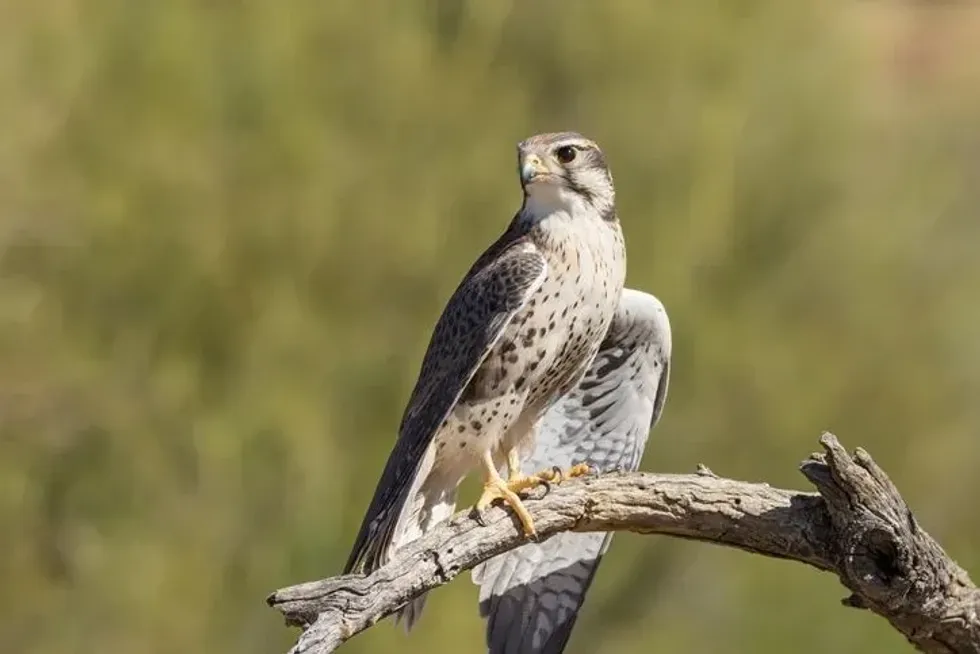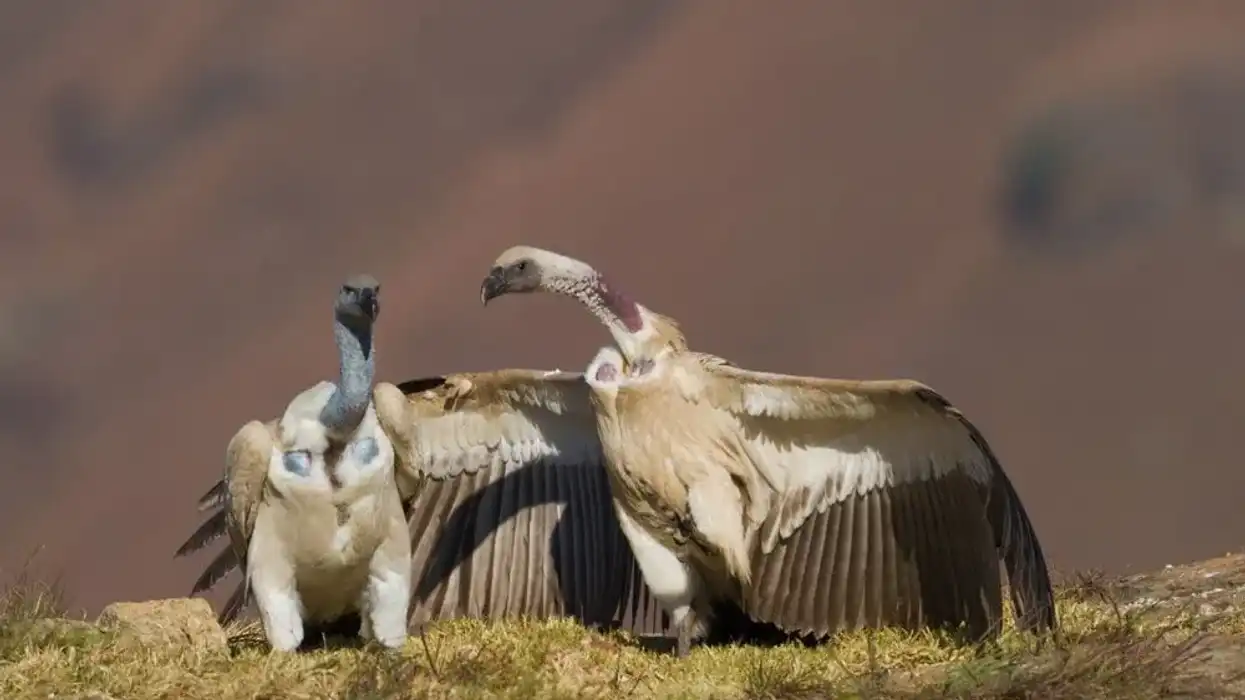The prairie falcon is one of the most aggressive and territorial birds of the desert, with both a scary reputation and an intimidating size.
The fact that they can hunt their prey weighing more than their own size helps to put them on the Apex predator list, meaning they have no natural predators and can be found at the top of the food chain.
They are one of the most effective falconry birds, second only to the peregrine falcon.
The prairie falcon (Falco mexicanus), from the order Falconiformes, is a medium-sized North American bird. These North American birds are also classified as birds of prey.
These birds are famous for their flawless dives. They can dive at great speeds to catch their prey. It all happens so impressively fast, and their prey usually has no time to react.
There are so many similarities between a prairie falcon and a peregrine falcon that it makes the prairie falcon vs. peregrine falcon debate an interesting topic of discussion. Keep reading in order to gain more knowledge about the living habits of prairie falcons and how they are similar to, and different from, peregrine falcons.
If you like this, then you can also read about the sea eagle and the chicken hawk.
Prairie Falcon Interesting Facts
What type of animal is a prairie falcon?
The prairie falcon (Falco mexicanus) is a bird from the order Falconiformes.
What class of animal does a prairie falcon belong to?
Prairie falcons are a falcon species that belongs to the class of Aves.
How many prairie falcons are there in the world?
The exact prairie falcon population is not known. It has been observed that prairie falcon populations have not been drastically affected by pesticides (unlike the peregrine falcon population has). The prairie falcon's population has actually been growing significantly since 2006.
Where does a prairie falcon live?
The prairie falcon can survive in almost all kinds of habitats, making them one of the most common birds in North America. The prairie falcon range stretches from British Columbia, Alberta, and Saskatchewan in Canada to east Washington, Texas, and North Dakota in the United States.
Various sub-species of prairie falcons are also found in eastern countries, including in India.
What is a prairie falcon's habitat?
The prairie falcon is a common species of birds and can be spotted relatively easily. The prairie falcon is known to survive best in temperate grasslands, tundra regions, shrublands, xeric shrublands, wetlands, and deserts. They are quite adaptable in nature and can survive in almost all types of conditions.
Who do prairie falcons live with?
Prairie falcons are known to spend most of their lives alone, they are solitary birds. However, during the breeding season, they get together with other prairie falcons to mate.
How long does a prairie falcon live?
Prairie falcons tend to have a lifespan of 15 years. But, they are known to survive for up to 20 years when kept in captivity.
How do they reproduce?
Prairie falcons are a species that is known to live a solitary life. However, they can be seen with other prairie falcons during their breeding season.
Males tend to display sky shows for females in order to impress them and gain their approval.
Their breeding season starts in February and continues until July, with the months of April, May, and June being the prime time for mating during this season. They are known to breed only once a year and prairie falcons (male and female) don't need to build an entire nest for breeding.
Instead, they stay on cliff edges and don't mind laying their eggs there. The female is known to lay approximately three to five eggs (with brown spots on the eggs) and there is an incubation period of 31 days for the eggs to hatch.
During the incubation period, the male brings food to the female, while she does most of the incubating. After the incubation period, the male brings food for the newborn birds (called eyas and eyass birds) and for the female bird.
The newborn birds live with their parents until they learn to fly and hunt by themselves.
After a period of approximately 65 days, they become independent enough to fend for themselves and are ready to leave their parents. They achieve sexual maturity after two years, and the entire cycle is repeated all over again.
What is their conservation status?
Prairie falcons are listed as a species of Least Concern by the IUCN. They are quite a common species of birds and can be relatively easily spotted in the wild. The population of this bird species has also been steadily increasing.
Prairie Falcon Fun Facts
What do prairie falcons look like?
Prairie falcons are medium to large-sized birds with a wingspan of 35-45 in (88-114 cm) and an average weight of 0.92-2.4 lb (0.42–1.1 kg). These beautiful birds tend to have a body covered with beautiful soft feathers that are dipped in various shades of colors.
While the top side is brown in color, the tail displays a lighter shade. Their feathers have a duskier shade of brown, while the wing pits and under wigs are jet black.
Adults and juveniles are distinguished by looks as juveniles tend to have a lighter shade of gray on the top side of their bodies, while their belly is dipped in dark-streaked brown.
These birds have a body structure that is specially designed for hunting and surviving. They have strong pointed wings, helping them with their speed and distance, and a hook-shaped pointed beak in order to catch prey.
This beak shape increases the power of their grip and hold, and they have strong claws to lift up their prey wherever required. These birds are strong and attractive at the same time.

How cute are they?
The prairie falcon is known for its hunting skills and its strength, while its overall appearance and the beautiful subtle colors of its wings make it an attractive bird.
How do they communicate?
These birds are known to use vocal sounds to communicate. They have different calls for when their territory is being invaded, when their nests are under threat, when they are communicating with their partners and when they are catching prey for food.
They tend to make a 'kik-kik' and 'kree-kree' sound during their calls and they carry out an ariel show to attract a mate. This is one of the major forms of communication displayed by these birds during their breeding season.
How big is a prairie falcon?
The prairie falcon grows up to a length of 13-18 in (35-47 cm). These large birds are known for their strength, and their strength and their body structure both help them to hunt better and survive for longer.
These birds of prey are referred to as large or medium-sized birds and they are three times larger than an average sparrow. When compared to the very similar peregrine falcons, the prairie falcon is just slightly smaller.
How fast can a prairie falcon fly?
The basic speed of an average prairie falcon is known to be 46 mph (75 kph). However, this species of bird can dive at speeds of over 120 mph (194 kph).
How much does a prairie falcon weigh?
They weigh around 0.92-2.4 lb (0.42–1.1 kg).
What are their male and female names of the species?
There are no specific names for each gender.
What would you call a baby prairie falcon?
Young prairie falcons are called eyas and eyass.
What do they eat?
They prey primarily on ground squirrels, small mammals, pigeons, and mourning doves. These birds of prey have high nutritional needs that must be fulfilled. To fulfill the nutritional requirements of their bodies, they are well equipped with effective claws and wings to be able to hunt, eat and survive.
Are they dangerous?
Their aggressive nature and hunting habits mean that they are on the top of the food chain, and most smaller birds below them tend to become their prey. These birds are considered to be quite dangerous based on their impressive and aggressive hunting skills.
Would they make a good pet?
Prairie falcons are the most famous falconry birds used for falconry in the United States, but they are not suitable pets. They are aggressive birds, who need to be looked after by someone with high levels of expertise if they are kept in captivity.
Did you know...
Prairie falcons are non-migratory but will move short distances during the breeding season and during winter. They also move depending on food availability. Despite this, most adults will permanently stay at their nesting sites throughout their lives if the food supply there is abundant.
They fight with other birds, sometimes for a common prey.
Training a prairie falcon can be difficult, especially if you are new to falconry. Newcomers to the world of falconry should consider less aggressive birds to start with.
When it comes to the prairie falcon, the most important part of their training is trust.
You absolutely need to gain their trust in order to proceed with their training.
You can accomplish this by feeding them and spending lots of time with them to help them become familiar with you. Next, you can train them to sit on your gloves by placing food on your gloves after they have flown away.
You also need to train the falcon to fly further away from you, and to do this you can try using a kite with a piece of food hanging from it and letting the bird fly to get to it.
The bond between you and your bird will slowly develop as you develop your falconry skills, and you will find that these prairies are some of the best birds to do this activity with.
You can take training courses from experienced professionals in this field to get better at falconry.
The prairie falcon's call
The prairie falcon call is a 'kik-kik' sound that they use in order to communicate with their fellow falcons. Their calls are pretty famous.
The famous theory behind a falcon's calls is that these calls are their reaction to a breeding territory intruder. When they witness an intruder, they tend to produce a shrill-like yelping noise. The frequency or duration of these calls varies from situation to situation and from falcon to falcon.
How fast can prairie falcons dive?
They can dive at a speed of at least 120 mph (194 kph). One of the best prairie falcon dive facts is that these North American birds are quite famous for their dives.
These birds tend to dive from high altitudes to catch their prey, including ground squirrels, small birds, and mammals. Their swift, effortless smooth dives help them reach the ground faster and hence hunt their desired prey.
Here at Kidadl, we have carefully created lots of interesting family-friendly animal facts for everyone to discover! Learn more about some other birds, including the great tit, or the Eurasian collared dove.
You can even occupy yourself at home by drawing one on our Prairie falcon coloring pages.










